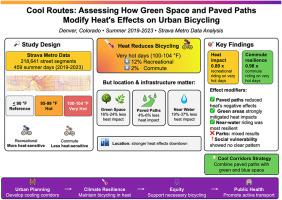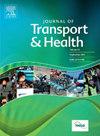Cool routes: Assessing how green space and paved paths modify heat's effects on urban bicycling
IF 3.3
3区 工程技术
Q2 PUBLIC, ENVIRONMENTAL & OCCUPATIONAL HEALTH
引用次数: 0
Abstract
Background
Understanding how heat's effect on bicycling varies spatially across the urban environment can inform who may be bicycling in the heat and how urban-planning measures can improve thermal comfort for bicyclists.
Objective
We estimated effects of heat on recreational and commute bicycling in Denver, Colorado, USA using city-wide, finely resolved bicycling data and assessed heterogeneity in effects by area-level social vulnerability and proximity to the city center and whether off-street paths and green-space measures, if intervened upon, modify these effects.
Methods
From Strava Metro, we obtained daily data on recreational and commute bicycling in Denver on each street segment (N = 218,641) during the summer months of 2019–2023. We estimated effects of hot (95–99 °F [35–37 °C]) and very hot (100–104 °F [38–40 °C]) temperature on daily bicycling using model-based standardization, controlling for temporally varying confounders. We assessed effect heterogeneity by area-level social vulnerability and proximity to the city center. To assess effect modification by intervention (defined in text) of paved paths and green-space measures, we additionally controlled for social vulnerability and proximity to the urban core.
Results
Heat's attenuating effects on recreational and commute bicycling were stronger in central Denver but did not differ across area-level social vulnerability. Heat's attenuating effects were somewhat weaker on off-street paths and considerably weaker in greener areas and near blue space.
Conclusions
Results support the provision of paved paths and access to green and blue space to support bicycling during hot weather.

凉爽的路线:评估绿地和铺砌的道路如何改变热量对城市自行车的影响
了解热量对骑自行车的影响在城市环境中的空间变化,可以了解哪些人可能在高温下骑自行车,以及城市规划措施如何改善骑自行车者的热舒适。目的:利用美国科罗拉多州丹佛市范围内的精细分解的自行车数据,评估热量对休闲和通勤自行车的影响,并通过区域级社会脆弱性和与市中心的接近程度评估影响的异质性,以及如果干预,非街道路径和绿色空间措施是否可以改变这些影响。方法从Strava Metro获取2019-2023年夏季丹佛市各街道休闲和通勤自行车的每日数据(N = 218,641)。我们使用基于模型的标准化方法估算了高温(95-99°F[35-37°C])和高温(100-104°F[38-40°C])对日常骑行的影响,并控制了时间变化的混杂因素。我们通过区域层面的社会脆弱性和靠近城市中心来评估效果的异质性。为了评估铺砌道路和绿色空间措施的干预效果,我们还控制了社会脆弱性和靠近城市核心的程度。结果丹佛市中心对休闲骑行和通勤骑行的减弱作用较强,但在不同地区的社会脆弱性差异不大。热量的衰减效应在非街道路径上略弱,在绿色区域和靠近蓝色空间的地方则明显弱。结论:研究结果支持在炎热的天气里提供铺砌的道路和绿色和蓝色空间,以支持骑自行车。
本文章由计算机程序翻译,如有差异,请以英文原文为准。
求助全文
约1分钟内获得全文
求助全文

 求助内容:
求助内容: 应助结果提醒方式:
应助结果提醒方式:


